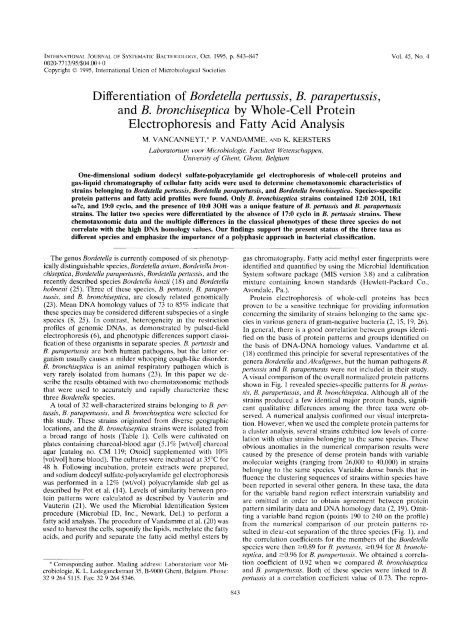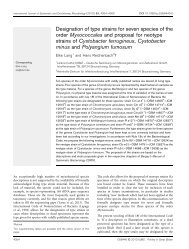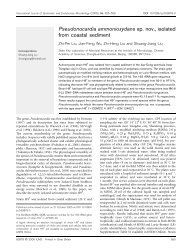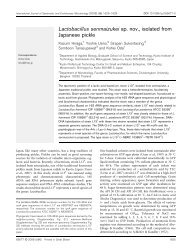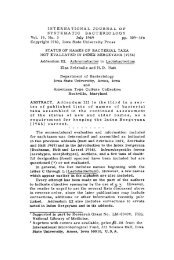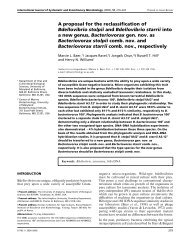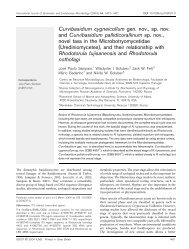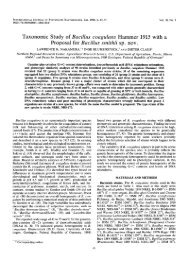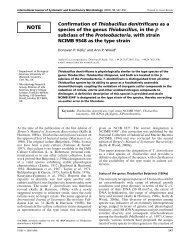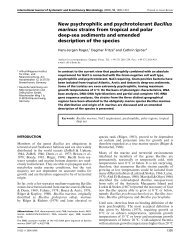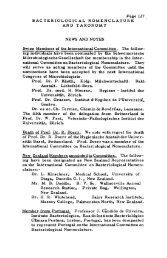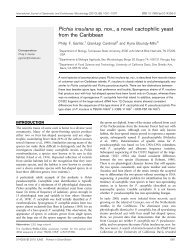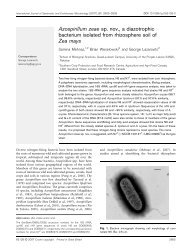Differentiation of Bordetella pertussis, B. parapertussis,
Differentiation of Bordetella pertussis, B. parapertussis,
Differentiation of Bordetella pertussis, B. parapertussis,
You also want an ePaper? Increase the reach of your titles
YUMPU automatically turns print PDFs into web optimized ePapers that Google loves.
INTEKNATIONAL JOURNAL OF SYSTEMATIC BACTERIOLOGY, Oct. 1995, p. 843-847<br />
0020-7713/95/$04.0O+ 0<br />
Copyright 0 1995, International Union <strong>of</strong> Microbiological Societies<br />
<strong>Differentiation</strong> <strong>of</strong> <strong>Bordetella</strong> <strong>pertussis</strong>, B. para<strong>pertussis</strong>,<br />
and B. bronchiseptica by Whole-Cell Protein<br />
Electrophoresis and Fatty Acid Analysis<br />
M. VANCANNEYT," P. VANDAMME, AND K. KERSTERS<br />
Laboratorium voor Microbiologie, Facidteit Wetenschappen,<br />
University <strong>of</strong> Ghent, Ghent, Belgium<br />
One-dimensional sodium dodecyl sulfate-polyacrylamide gel electrophoresis <strong>of</strong> whole-cell proteins and<br />
gas-liquid chromatography <strong>of</strong> cellular fatty acids were used to determine chemotaxonomic characteristics <strong>of</strong><br />
strains belonging to <strong>Bordetella</strong> <strong>pertussis</strong>, <strong>Bordetella</strong> para<strong>pertussis</strong>, and <strong>Bordetella</strong> bronchiseptica. Species-specific<br />
protein patterns and fatty acid pr<strong>of</strong>iles were found. Only B. bronchiseptica strains contained 12:O 20H, 18:l<br />
W~C, and 19:O cyclo, and the presence <strong>of</strong> 1O:O 30H was a unique feature <strong>of</strong> B. <strong>pertussis</strong> and B. para<strong>pertussis</strong><br />
strains. The latter two species were differentiated by the absence <strong>of</strong> 17:0 cyclo in B. <strong>pertussis</strong> strains. These<br />
chemotaxonomic data and the multiple differences in the classical phenotypes <strong>of</strong> these three species do not<br />
correlate with the high DNA homology values. Our findings support the present status <strong>of</strong> the three taxa as<br />
different species and emphasize the importance <strong>of</strong> a polyphasic approach in bacterial classification.<br />
The genus <strong>Bordetella</strong> is currently composed <strong>of</strong> six phenotyp-<br />
ically distinguishable species, <strong>Bordetella</strong> avium, <strong>Bordetella</strong> bron-<br />
chiseptica , <strong>Bordetella</strong> para<strong>pertussis</strong>, <strong>Bordetella</strong> <strong>pertussis</strong>, and the<br />
recently described species <strong>Bordetella</strong> hinzii (18) and <strong>Bordetella</strong><br />
holmesii (25). Three <strong>of</strong> these species, B. <strong>pertussis</strong>, B. paraper-<br />
tussis, and B. bronchiseptica, are closely related genomically<br />
(23). Mean DNA homology values <strong>of</strong> 73 to 85% indicate that<br />
these species may be considered different subspecies <strong>of</strong> a single<br />
species (8, 25). In contrast, heterogeneity in the restriction<br />
pr<strong>of</strong>iles <strong>of</strong> genomic DNAs, as demonstrated by pulsed-field<br />
electrophoresis (6), and phenotypic differences support classi-<br />
fication <strong>of</strong> these organisms in separate species. B. <strong>pertussis</strong> and<br />
B. para<strong>pertussis</strong> are both human pathogens, but the latter or-<br />
ganism usually causes a milder whooping cough-like disorder.<br />
B. bronchiseptica is an animal respiratory pathogen which is<br />
very rarely isolated from humans (23). In this paper we de-<br />
scribe the results obtained with two chemotaxonomic methods<br />
that were used to accurately and rapidly characterize these<br />
three <strong>Bordetella</strong> species.<br />
A total <strong>of</strong> 32 well-characterized strains belonging to B. per-<br />
tussis, B. para<strong>pertussis</strong>, and B. bronchiseptica were selected for<br />
this study. These strains originated from diverse geographic<br />
locations, and the B. bronchiseptica strains were isolated from<br />
a broad range <strong>of</strong> hosts (Table 1). Cells were cultivated on<br />
plates containing charcoal-blood agar (5.1 % [wt/vol] charcoal<br />
agar [catalog no. CM 119; Oxoid] supplemented with 10%<br />
[volivol] horse blood). The cultures were incubated at 35°C for<br />
48 h. Following incubation, protein extracts were prepared,<br />
and sodium dodecyl sulfate-polyacrylamide gel electrophoresis<br />
was performed in a 12% (wt/vol) polyacrylamide slab gel as<br />
described by Pot et al. (14). Levels <strong>of</strong> similarity between pro-<br />
tein patterns were calculated as described by Vauterin and<br />
Vauterin (21). We used the Microbial Identification System<br />
procedure (Microbial ID, Inc., Newark, Del.) to perform a<br />
fatty acid analysis. The procedure <strong>of</strong> Vandamme et al. (20) was<br />
used to harvest the cells, saponify the lipids, methylate the fatty<br />
acids, and purify and separate the fatty acid methyl esters by<br />
* Corresponding author. Mailing address: Laboratorium voor Mi-<br />
crobiologie, K. L. Ledeganckstraat 35, B-9000 Ghent, Belgium. Phone:<br />
32 9 264 5115. Fax: 32 9 264 5346.<br />
843<br />
Vol. 45, No. 4<br />
gas chromatography. Fatty acid methyl ester fingerprints were<br />
identified and quantified by using the Microbial Identification<br />
System s<strong>of</strong>tware package (MIS version 3.8) and a calibration<br />
mixture containing known standards (Hewlett-Packard Co.,<br />
Avondale, Pa.).<br />
Protein electrophoresis <strong>of</strong> whole-cell proteins has been<br />
proven to be a sensitive technique for providing information<br />
concerning the similarity <strong>of</strong> strains belonging to the same spe-<br />
cies in various genera <strong>of</strong> gram-negative bacteria (2, 15, 19, 26).<br />
In general, there is a good correlation between groups identi-<br />
fied on the basis <strong>of</strong> protein patterns and groups identified on<br />
the basis <strong>of</strong> DNA-DNA homology values. Vandamme et al.<br />
(1 8) confirmed this principle for several representatives <strong>of</strong> the<br />
genera <strong>Bordetella</strong> and Alcaligenes, but the human pathogens B.<br />
<strong>pertussis</strong> and l?. para<strong>pertussis</strong> were not included in their study.<br />
A visual comparison <strong>of</strong> the overall normalized protein patterns<br />
shown in Fig. 1 revealed species-specific patterns for B. pertus-<br />
sis, B. para<strong>pertussis</strong>, and B. hronchiseptica. Although all <strong>of</strong> the<br />
strains produced a few identical major protein bands, signifi-<br />
cant qualitative differences among the three taxa were ob-<br />
served. A numerical analysis confirmed our visual interpreta-<br />
tion. However, when we used the complete protein patterns for<br />
a cluster analysis, several strains exhibited low levels <strong>of</strong> corre-<br />
lation with other strains belonging to the same species. These<br />
obvious anomalies in the numerical comparison results were<br />
caused by the presence <strong>of</strong> dense protein bands with variable<br />
molecular weights (ranging from 26,000 to 40,000) in strains<br />
belonging to the same species. Variable dense bands that in-<br />
fluence the clustering sequences <strong>of</strong> strains within species have<br />
been reported in several other genera. In these taxa, the data<br />
for the variable band region reflect interstrain variability and<br />
are omitted in order to obtain agreement between protein<br />
pattern similarity data and DNA homology data (2, 19). Omit-<br />
ting a variable band region (points 190 to 240 on the pr<strong>of</strong>ile)<br />
from the numerical comparison <strong>of</strong> our protein patterns re-<br />
sulted in clear-cut separation <strong>of</strong> the three species (Fig. l), and<br />
the correlation coefficients for the members <strong>of</strong> the <strong>Bordetella</strong><br />
species were then 20.89 for B. <strong>pertussis</strong>, 10.94 for B. bronchi-<br />
septica, and 20.96 for B. para<strong>pertussis</strong>. We obtained a correla-<br />
tion coefficient <strong>of</strong> 0.92 when we compared B. bronchiseptica<br />
and B. para<strong>pertussis</strong>. Both <strong>of</strong> these species were linked to B.<br />
<strong>pertussis</strong> at a correlation coefficient value <strong>of</strong> 0.73. The repro-
844 NOTES INT. J. SYST. BACTERIOL.<br />
TABLE 1. <strong>Bordetella</strong> strains studied<br />
Species Strain' Designation as received' Source<br />
B. bronchiseptica LMG 1232Th<br />
LMG 1807<br />
LMG 1809<br />
LMG 1811<br />
LMG 3521t1<br />
LMG 3531<br />
LMG 3535<br />
LMG 3538<br />
LMG 3542<br />
LMG 14526<br />
B. para<strong>pertussis</strong><br />
LMG 1816<br />
LMG 1818<br />
LMG 1819<br />
LMG 1820<br />
LMG 1825<br />
LMG 1827<br />
LMG 1833<br />
LMG 14449T<br />
LMG 14450<br />
LMG 14451<br />
B. <strong>pertussis</strong><br />
LMG 14452<br />
LMG 14453<br />
LMG 14454<br />
LMG 14455=<br />
LMG 14522<br />
LMG 15140<br />
LMG 15141<br />
LMG 15142<br />
LMG 15585<br />
LMG 15586<br />
LMG 15587<br />
LMG 15589<br />
NCTC 452T<br />
NCTC 455<br />
NCTC 8751<br />
NCTC 10540<br />
Hinz 40-81<br />
NCTC 458<br />
CCM 6048<br />
CCM 6155<br />
CCUG 7865<br />
CCUG 31300<br />
NCTC 7385<br />
NCTC 10853<br />
CNCTC Hpp 5/59<br />
NCTC 10520<br />
NCTC 10525<br />
CNCTC Hpp 1/58<br />
NCTC 8250<br />
CCUG 413T<br />
CCUG 882A<br />
CCUG 4099<br />
CCUG 699<br />
CCUG 9818<br />
CCUG 17283<br />
CCUG 30873T<br />
CCUG 32523<br />
CCUG 13475<br />
CCUG 15610<br />
CCUG 23702<br />
CHMC 237-731<br />
CHMC 212-422<br />
CHMC 266-1003<br />
CHMC 244-889<br />
Dog lung<br />
Ferret trachea (1913)<br />
Guinea pig lung<br />
Whooping cough-like disease (United States, 1949)<br />
Turkey trachea (Germany)<br />
Human sputum (1913)<br />
Rabbit<br />
Dog<br />
Human nasopharynx (Boris, Sweden, 1979)<br />
Cough plate<br />
Human<br />
Whooping cough<br />
Human nasopharynx (Goteborg, Sweden, 1974)<br />
Human nasopharynx (Goteborg, Sweden, 1970)<br />
Human nasopharynx (Goteborg, Sweden, 1980)<br />
Human (Stockholm, Sweden, 1994)<br />
Human (Viixjo, Sweden, 1988)<br />
Human (Cincinnati, Ohio)<br />
Human (Cincinnati, Ohio)<br />
Human (Cincinnati, Ohio)<br />
Human (Cincinnati, Ohio)<br />
~ ~ ~~ ~~ ~~~ ~~~ ~ ~~<br />
' CCM, Czechoslovak Collection <strong>of</strong> Microorganisms, Brno, Czech Republic; CCUG, Culture Collection <strong>of</strong> the University <strong>of</strong> Goteborg, Department <strong>of</strong> Clinical<br />
Bacteriology, University <strong>of</strong> Goteborg, Goteborg, Sweden; CHMC, Children's Hospital Medical Center, Cincinatti, Ohio; CNCTC, Czechoslovak National Collection<br />
<strong>of</strong> Type Cultures, Institute <strong>of</strong> Hygiene and Epidemiology, Prague, Czech Republic; Hinz, K. H. Hinz, Klinik fur Geflugel, der Tierarztlichen Hochschule Hannover,<br />
Hannover, Germany; LMG, Culture Collection <strong>of</strong> the Laboratorium voor Microbiologie, University <strong>of</strong> Ghent, Ghent, Belgium; NCTC, National Collection <strong>of</strong> Type<br />
Cultures, Central Public Health Laboratory, London, United Kingdom<br />
T = type strain.<br />
ducibility <strong>of</strong> the method was very good; the correlation coef-<br />
ficients for duplicate protein patterns were 20.96.<br />
The average fatty acid methyl ester compositions <strong>of</strong> B. bron-<br />
chiseptica, B. para<strong>pertussis</strong>, and B. <strong>pertussis</strong> were also investi-<br />
gated (Table 2). The standard deviations indicated that there<br />
were only minor intraspecific differences. The fatty acids<br />
present in all <strong>of</strong> the strains which we studied were 14:0, 15:0,<br />
16:0, 16:l 07c, 17:0, 18:0, and summed feature 3. Summed<br />
feature 3 comprised two fatty acids, 16:l is0 and 14:O 30H,<br />
which could not be distinguished by the Microbial Identifica-<br />
tion System. Vandamme et al. (18) and Weyant et al. (25)<br />
reported that the peak designated summed feature 3 probably<br />
corresponds to 14:O 30H. An examination <strong>of</strong> the cellular fatty<br />
acid pr<strong>of</strong>iles revealed that the three taxa could be clearly dis-<br />
tinguished. B. bronchiseptica strains were distinguished from all<br />
other strains by small but significant amounts <strong>of</strong> fatty acids 12:O<br />
20H, 19:0 cyclo 08c, and summed feature 7. The results <strong>of</strong> a<br />
study performed by Weyant et al. (25) indicated that summed<br />
feature 7, which comprises three isomers <strong>of</strong> 18:1, is probably<br />
18:l 07c. Furthermore, B. bronchiseptica lacked the hydroxy<br />
fatty acid 1O:O 30H, which was present in considerable<br />
amounts in B. <strong>pertussis</strong> and B. para<strong>pertussis</strong>. The latter two<br />
species were easily differentiated by the absence <strong>of</strong> 17:O cyclo<br />
in B. <strong>pertussis</strong> strains and the much higher level <strong>of</strong> 16:l 07c in<br />
these strains.<br />
The fatty acid compositions <strong>of</strong> the <strong>Bordetella</strong> species consid-<br />
ered in this study have been determined previously by other<br />
workers (4, 5, 11, 18, 25). Jantzen et al. (5) and Weyant et al.<br />
(25) studied representatives <strong>of</strong> all three species. Jantzen et al.<br />
(5) confirmed that the three <strong>Bordetella</strong> species could be differ-<br />
entiated easily. However, these authors indicated that all <strong>of</strong> the<br />
fatty acids detected except 17:O cyclo were present in at least<br />
trace amounts in all three species. Using the standardized<br />
procedure, we identified additional qualitative differences in<br />
the fatty acid pr<strong>of</strong>iles which may be used as diagnostic markers.<br />
Only B. bronchiseptica strains contained 12:O 20H, 18:l 07c<br />
(summed feature 7), and 19:O cyclo, and 10:0 30H was found<br />
only in B. <strong>pertussis</strong> and B. para<strong>pertussis</strong> strains (Table 2). Jant-<br />
Zen et al. (5) also indicated that B. <strong>pertussis</strong> strains produced<br />
small amounts <strong>of</strong> CI1, CI3, and C,, 3-hydroxy acids. Our re-<br />
sults, which were based on alkaline (not acidic) release <strong>of</strong> fatty<br />
acids, showed that only the type strain <strong>of</strong> B. <strong>pertussis</strong> contained<br />
a significant amount <strong>of</strong> 1l:O 30H (Table 2), and the other two<br />
fatty acids were not detected.<br />
Weyant et al. (25) determined the cellular fatty acid com-<br />
positions <strong>of</strong> only two or three strains <strong>of</strong> each <strong>of</strong> the three<br />
species. The low numbers <strong>of</strong> strains, which were isolated from<br />
a restricted geographic area, yielded limited data concerning<br />
the variability <strong>of</strong> the fatty acid compcrsitions <strong>of</strong> the strains <strong>of</strong><br />
these species. Therefore, some <strong>of</strong> the fatty acids which were<br />
used to differentiate their strains may not be useful as general,<br />
species-specific, diagnostic markers. Our data, which were
VOL. 45, 1995 NOTES 845<br />
FIG. 1. Normalized photograph <strong>of</strong> sodium dodecyl sulfate-polyacrylamide protein elcctropherograms for the strains studied and corresponding dendrogram based<br />
on an average-linkage cluster analysis <strong>of</strong> correlation coefficients (r values). The molecular weight markers used (track LMWM) were (from left to right) lysozymc<br />
(molecular weight, 14,500), trypsin inhibitor (20,100), carbonic anhydrase (29,000), glyceraldehyde-3-phosphate dehydrogenase (36,000), egg albumin (45,000), bovine<br />
albumin (66,000), and P-galactosida%e (1 16,000).<br />
based on a larger and more diverse set <strong>of</strong> strains, showed that<br />
15:O and 17:O fatty acids were present in all three species and<br />
not only in B. para<strong>pertussis</strong> as suggested by Weyant et al. (25).<br />
Moreover, 12:O 30H fatty acid occurred in some <strong>of</strong> the strains<br />
<strong>of</strong> both B. bronchiseptica and B. <strong>pertussis</strong>, not only in B. per-<br />
tussis strains.<br />
In two other studies (11, 18) focusing on avian isolates the<br />
researchers included only the broad-host-range pathogen B.<br />
bronchiseptica. These authors obtained qualitatively very sim-<br />
ilar patterns compared with our data. Jackwood et al. (4)<br />
examined B. bronchiseptica and B. para<strong>pertussis</strong> strains. An<br />
important qualitative difference between the data <strong>of</strong> these au-<br />
thors and our data was the presence <strong>of</strong> significant amounts <strong>of</strong><br />
18:l in B. para<strong>pertussis</strong> in their study. Obviously, in all <strong>of</strong> these<br />
studies quantitative differences in fatty acid contents may have<br />
been due to different incubation conditions (3). Finally, fatty<br />
acid fingerprint data obtained from previous studies demon-<br />
strated that B. bronchiseptica, B. para<strong>pertussis</strong>, and B. <strong>pertussis</strong><br />
can be easily distinguished from B. aviurn, B. hinzii, and B.<br />
holmesii by their lack <strong>of</strong> significant amounts <strong>of</strong> 14:O 20H (11,<br />
18,25). This confirms the importance <strong>of</strong> hydroxy fatty acids as<br />
taxonomic markers in the classification <strong>of</strong> gram-negative bac-<br />
teria, as demonstrated previously in several studies (12, 15, 17,<br />
28).<br />
Both <strong>of</strong> the chemotaxonomic methods which we used a[-<br />
lowed us to characterize and identify three clearly different<br />
taxa, B. bronchiseptica, B. para<strong>pertussis</strong>, and B. <strong>pertussis</strong>, which<br />
suggests that species rank is justified for each <strong>of</strong> thcse taxa.<br />
Indeed, in general, strains belonging to the same species ex-<br />
hibit only minor quantitative differences in their fatty acid<br />
pr<strong>of</strong>iles (10,24), and we and other workers (4, 11, 18,25) have<br />
found significant qualitative differences among these three
846 NOTES INT. J. SYST. BACTERIOL.<br />
TABLE 2. Fatty acid compositions <strong>of</strong> the species investigated<br />
~~<br />
% <strong>of</strong> total fatty acids<br />
Fatty acid" B. bronchiseptica R. para<strong>pertussis</strong> B. <strong>pertussis</strong><br />
(10 strains) (10 strains) (12 strains)<br />
10:0 30H ND" 2.5 2 0.2 (lay 2.4 +- 0.9 (12)<br />
12:o<br />
12:O 20H<br />
Tr (8)<br />
3.2 t 0.4 (10)<br />
ND<br />
ND<br />
ND<br />
ND<br />
12:O 30H<br />
14:O<br />
Tr (9)<br />
6.4 +. 0.2 (10)<br />
ND<br />
6.5 f 1.0 (10)<br />
Tr (8)<br />
4.4 t 0.4 (12)<br />
15:o 1.1 +. 0.6 (10) 1.0 t 0.3 (10) 2.0 +- 1.1 (12)<br />
15:l 06c ND<br />
ND 1.1 2 0.9 (11)<br />
16:O 36.0 +. 0.7 (10) 40.9 2 1.7 (10) 30.6 t 4.4 (12)<br />
16:l w5c<br />
16:l 07c<br />
Tr (7)<br />
2.8 t 0.8 (10)<br />
Tr (3)<br />
2.8 ? 1.7 (10)<br />
ND<br />
39.9 t 1.0 (12)<br />
160 30H<br />
17:O<br />
Tr (9)<br />
1.7 t 0.7 (lo)<br />
Tr (3)<br />
2.3 t 1.1 (10)<br />
ND<br />
3.2 t 1.8 (12)<br />
17:0 cyclo<br />
18:O<br />
33.5 t 2.2 (10) 34.4 t 2.7 (10)<br />
2.2 t 0.4 (10) 3.5 +- 1.4 (10)<br />
ND<br />
5.7 t 1.9 (12)<br />
18:l 09c<br />
190 cyclo 08c<br />
ND<br />
1.1 t 0.4 (10)<br />
ND<br />
ND<br />
Tr (6)<br />
ND<br />
Summed feature 3 8.0 f 1.1 (10) 5.9 t 0.9 (10) 8.5 2 1.8 (12)<br />
Summed feature 6 ND<br />
ND 1.1 2 0.5 (10)<br />
Summed feature 7 2.2 t 1.4 (10) ND<br />
ND<br />
1l:O 30H Fatty acid was found in B. <strong>pertussis</strong> LMG 14455"' at a level <strong>of</strong> l.6%,<br />
and lY:0 iso fatty acid was detected in B. bronchiseptica LMG 181 1 at a level <strong>of</strong><br />
0.5%. Summed features represent groups <strong>of</strong> two or three fatty acids which could<br />
not be separated under the gas chromatographic conditions used in this study.<br />
Summed feature 3 contained 14:O 30H or 16:l iso or both; summed feature 6<br />
contained 189 anteiso or 18:2 w6,9c or both; and summed feature 7 contained<br />
18:l w7c, 18:l wYt, or 18:l w12t or any combination <strong>of</strong> these fatty acids.<br />
" ND, not detected.<br />
' Mean t standard deviation. The numbers in parentheses are the numbers <strong>of</strong><br />
strains which contained the fatty acid.<br />
taxa. In addition, the differences in the protein patterns, espe-<br />
cially the differences between B. <strong>pertussis</strong> and the other two<br />
species, were considerable and cannot be compared with dif-<br />
ferences that occur between electrophoretic types within a<br />
single species, as has been reported previously for B. hinzii and<br />
B. aviurn (18). The chemotaxonomic data described above cor-<br />
roborate the different phenotypic and immunological charac-<br />
teristics <strong>of</strong> the three species (7,13) and may reflect the species-<br />
specific pr<strong>of</strong>iles obtained after macrorestriction digestion <strong>of</strong><br />
the DNAs (6). However, our data contradicted the unexpect-<br />
edly high DNA homology values obtained with these species<br />
(8, 18,25). When genera representing the different lineages in<br />
the Proteobacteria are considered, it is very uncommon to find<br />
closely related strains that exhibit such a high level <strong>of</strong> pheno-<br />
typic diversity, including chemotaxonomic diversity. In general,<br />
we believe that the standard for delineating species defined by<br />
Wayne et al. (22) is a good standard. However, the 70% DNA<br />
homology rule is also unsatisfactory in many genera, including<br />
the genera Acinetobacter (l), Aeromonas (9), Capnocytophaga<br />
(16), and Cornamonas (27); in these genera different genotypic<br />
groups exhibit no homology or considerably less than 70%<br />
DNA homology and cannot be distinguished by phenotypic<br />
characteristics. We strongly believe that delineation <strong>of</strong> any<br />
taxonomic unit should be based on a consensus among geno-<br />
typic, chemotaxonomic, and phenotypic data, and therefore, in<br />
this exceptional situation, we consider B. <strong>pertussis</strong>, B. paraper-<br />
tussis, and B. bronchiseptica separate species.<br />
We thank the depositors <strong>of</strong> strains listed in Table 1. We also thank<br />
Urbain Torck and Dirk Dewettinck for performing the protein elec-<br />
trophoresis.<br />
P.V. is indebted to the National Fund for Scientific Research (Bel-<br />
gium) for a position as a postdoctoral research fellow. K.K. is indebted<br />
to the Fund for Medical Scientific Research, Belgium, for research and<br />
personnel grants. Part <strong>of</strong> this research was performed within the<br />
framework <strong>of</strong> CEC contract BI02-CT94-3098.<br />
REFERENCES<br />
1. Bouvet, P. J., and S. Jeanjean. 1986. Delineation <strong>of</strong> new proteolytic genomic<br />
species in the genus Acinetobacter. Res. Microbiol. 140:291-299.<br />
2. Costas, M. 1992. Classification, identification, and typing <strong>of</strong> bacteria by the<br />
analysis <strong>of</strong> their one-dimensional polyacrylamide gel electrophoretic protein<br />
patterns, p. 351-408. In A. Chambrach, M. J. Dunn, and B. J. Radola (ed.),<br />
Advances in electrophoresis, vol. 5. VCH Verlagsgesellschaft, Weinheim,<br />
Germany.<br />
3. Cronan, J. E. 1968. Phospholipid alterations during growth <strong>of</strong> Escherichia<br />
coli. J. Bacteriol. 9520542061.<br />
4. Jackwood, M. W., M. Sasser, and Y. M. Saif. 1986. Contribution to the<br />
taxonomy <strong>of</strong> the turkey coryza agent: cellular fatty acid analysis <strong>of</strong> the<br />
bacterium. Avian Dis. 30172-178.<br />
5. Jantzen, E., E. Knudsen, and R. Winsnes. 1982. Fatty acid analysis for<br />
differentiation <strong>of</strong> <strong>Bordetella</strong> and Brucella species. Acta Pathol. Microbiol.<br />
Immunol. Scand. Sect. B 90:353-359.<br />
6. Khattak, M. N., and R. C. Matthews. 1993. Genetic relatedness <strong>of</strong> <strong>Bordetella</strong><br />
species as determined by macrorestriction digests resolved by pulsed-field gel<br />
electrophoresis. Int. J. Syst. Bacteriol. 43:659-664.<br />
7. Khelef, N., B. Danve, M. J. Quentin-Millet, and N. Guiso. 1993. <strong>Bordetella</strong><br />
<strong>pertussis</strong> and <strong>Bordetella</strong> para<strong>pertussis</strong>: two immunologically distinct species.<br />
Infect. Immun. 61:486-490.<br />
8. Woos, W. E., N. Mohapatra, W. J. Dobrogosz, J. W. Ezzell, and C. R.<br />
Manclark 1981. Deoxyribonucleotide sequence relationships among Bordctella<br />
species. Int. J. Syst. Bacteriol. 31:173-176.<br />
9. Kuijper, E. J., A. G. Steigenvalt, B. S. C. I. M. Schoenmakers, M. F. Peeters,<br />
H. C. Zanen, and D. J. Brenner. 1989. Phenotypic characterization and DNA<br />
relatedness in human fecal isolates <strong>of</strong> Aeromonas spp. J. Clin. Microbiol.<br />
27~132-138.<br />
10. Miller, L., and T. Berger. 1985. Bacteria identification by gas chrornatogra-<br />
phy <strong>of</strong> whole-cell fatty acids. Hewlett-Packard Gas Chromatography Appli-<br />
cation Note 228-41. Hewlett-Packard Co., Palo Alto, Calif.<br />
11. Moore, C. J., H. Mawhinney, and P. J. Blackall. 1987. <strong>Differentiation</strong> <strong>of</strong><br />
<strong>Bordetella</strong> aviurn and related species by cellular fatty acid analysis. J. Clin.<br />
Microbiol. 25: 1059-1062.<br />
12. Oyaizu, H., and K. Komagata. 1983. Grouping <strong>of</strong> Pseudornonas species on<br />
the basis <strong>of</strong> cellular fatty acid composition and the quinone system with<br />
special reference to the existence <strong>of</strong> 3-hydroxy fatty acids. J. Gen. Appl.<br />
Microbiol. 29:17-40.<br />
13. Pittman, M. 1984. Genus <strong>Bordetella</strong> Moreno-Lopez 1952, 17gAL, p. 388-393.<br />
In N. R. Krieg and J. G. Holt (ed.), Bergey's manual <strong>of</strong> systematic bacteri-<br />
ology, vol. 1. The Williams & Wilkins Co., Baltimore.<br />
14. Pot, B., P. Vandamme, and K. Kersters. 1993. Analysis <strong>of</strong> electrophoretic<br />
whole-organism protein fingerprints, p, 493-521. In M. Goodfellow and<br />
A. G. O'Donnell (ed.), Chemical methods in prokaryotic systematics. J.<br />
Wiley and Sons, Chichester, United Kingdom.<br />
15. Segers, P., M. Vancanneyt, B. Pot, U. Torck, B. Hoste, D. Dewettinck, E.<br />
Falsen, K. Kersters, and P. De Vos. 1994. Classification <strong>of</strong> Pseudolnonas<br />
diminuta Leifson and Hugh 1954 and Pseudomonas vesicularis Busing, Doll,<br />
and Freytag 1953 in Brevundirnonas gen. nov. as Brevundimonas diminuta<br />
comb. nov. and Brevundimonas vesicularis comb. nov., respectively. Int. J.<br />
Syst. Bacteriol. 44499-510.<br />
16. Speck, H., R. M. Kroppenstedt, and W. Mannheim. 1987. Genomic relation-<br />
ships and species differentiation in the genus Capnocytophaga. Zentralbl.<br />
Bakteriol. Parasitenkd. Infektionskr. Hyg. Abt. 1 Orig. Reihe A 266:390-402.<br />
17. Suzuki, K., M. Goodfellow, and A. G. O'Donnell. 1993. Cell envelopes and<br />
classification, p. 195-238. In M. Goodfellow and A. G. O'Donnell (ed.),<br />
Handbook <strong>of</strong> new bacterial systematics. Academic Press, London.<br />
18. Vandamme, P., J. Hommez, M. Vancanneyt, M. Monsieurs, B. Hoste, B.<br />
Cookson, C. H. Wirsing von Konig, K. Kersters, and P. J. Blackall. 1995.<br />
<strong>Bordetella</strong> hinzii sp. nov., isolated from poultry and humans. Int. J. Syst.<br />
Bacteriol. 4537-45.<br />
19. Vandamme, P., B. Pot, E. Falsen, K. Kersters, and J. De Ley. 1990. Intra-<br />
and interspecific relationships <strong>of</strong> veterinary campylobacters revealed by nu-<br />
merical analysis <strong>of</strong> electrophoretic protein pr<strong>of</strong>iles and DNA:DNA hybrid-<br />
izations. Syst. Appl. Microbiol. 13:295-303.<br />
20. Vandamme, P., M. Vancanneyt, B. Pot, L. Mels, B. Hoste, D. Dewettinck, L.<br />
Vlaes, C. Van den Borre, R. Higgins, J. Hommez, K. Kersters, J.-P. Butzler,<br />
and H. Goossens. 1992. Polyphasic taxonomic study <strong>of</strong> the emended genus<br />
Arcobacter with Arcobacter butzlen comb. nov. and Arcohacter skirrowii sp.<br />
nov., an aerotolerant bacterium isolated from veterinary specimens. Int. J.<br />
Syst. Bacteriol. 42:344356.<br />
21. Vauterin, L., and P. Vauterin. 1992. Computer-aided objective comparison<br />
<strong>of</strong> electrophoresis patterns for grouping and identification <strong>of</strong> microorgan-<br />
isms. Eur. Microbiol. 1:37-41.<br />
22. Wayne, L. G., D. J. Brenner, R. R. Colwell, P. A. D. Grimont, 0. Kandler,<br />
M. I. Krichevsky, L. H. Moore, W. E. C. Moore, R. G. E. Murray, E.<br />
Stackebrandt, M. P. Starr, and H. G. Triiper. 1987. Report <strong>of</strong> the Ad Hoc
VOL. 45, 1995 NOTES 847<br />
Committee on Reconciliation <strong>of</strong> Approaches to Bacterial Systematics. Int. J.<br />
Syst. Bacteriol. 37:463-464.<br />
23. Weiss, A. A. 1992. The genus <strong>Bordetella</strong>, p. 2530-2543. In A. Balows, H. G.<br />
Truper, M. Dworkin, W. Harder, and K.-H. Schleifer (ed.), The prokaryotes,<br />
2nd ed., vol. 2. Springer-Verlag, Berlin.<br />
24. Welch, D. F. 1991. Applications <strong>of</strong> cellular fatty acid analysis. Clin. Micro-<br />
biol. Rev. 4422-438.<br />
25. Weyant, R. S., D. G. Hollis, R. E. Weaver, M. F. M. Amin, A. G. Steigerwalt,<br />
S. P. O’Connor, A. M. Whitney, M. I. Daneshvar, C. W. Moss, and D. J.<br />
Brenner. 1995. <strong>Bordetella</strong> holmesii sp. nov., a new gram-negative species<br />
associated with septicemia. J. Clin. Microbiol. 33:l-7.<br />
26. Willems, A,, M. Goor, S. Thielemans, M. Gillis, K. Kersters, and J. De Ley.<br />
1992. Transfer <strong>of</strong> several phytopathogenic Pseudomonas species to Ac-<br />
idovorax as Acidovorux avenue subsp. avenue subsp. nov., comb. nov., Ac-<br />
idovorax avenue subsp. citrulli, Acidovorax avenue subsp. cattleyae, and Ac-<br />
idovorax konjaci. Int. J. Syst. Bacteriol. 42:1O7-119.<br />
27. Willems, A., B. Pot, E. Falsen, P. Vandamme, M. Gillis, K. Kersters, and J.<br />
De Ley. 1991. Polyphasic taxonomic study <strong>of</strong> the emended genus Comamo-<br />
nus: relationship to Aquaspirillum aquaticum, E. Falsen group 10, and other<br />
clinical isolates. Int. J. Syst. Bacteriol. 41:427-444.<br />
28. Yabuuchi, E., I. Yano, H. Oyaizu, Y. Hashimoto, T. Ezaki, and H.<br />
Yamamoto. 1990. Proposals <strong>of</strong> Sphingomonas paucimobilis gen. nov. and<br />
comb. nov., Sphingomonas parapaucimobilis sp. nov., Sphingomonas yanoi-<br />
kuyae sp. nov., Sphingomonas adhaesiva sp. nov., Sphingomonas capsulata<br />
comb. nov., and two genospecies <strong>of</strong> the genus Sphingomonas. Microbiol.<br />
Immunol. 3499-1 10.


